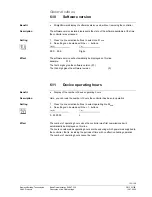
144/166
Siemens Building Technologies
Basic Documentation RVA47.320
CE1P2379E
HVAC Products
Application examples
15.07.2002
8 Application
examples
The RVA47.320 can control up to four modulating gas-fired heating boilers. For this
purpose, the boilers must be equipped with an appropriate BMU which controls the
boiler temperature.
In the controller’s internal cascade circuit, the RVA47.320 determines the order the
individual BMUs are switched on and off based on the output balance. The boilers are
thus switched on and off temperature over- or undershoot. The individual boilers are
controlled by the respective BMUs.
Furthermore, the controller can ensure the coordination of additional boiler controllers
of a cascade (cascade master function).
D.h.w. heating is provided either directly by the RVA47.320 or by one of the BMUs
based on the values adjusted on the RVA47.320.
•
The RVA47.320 accepts and handles heat demand signals of additional controllers
connected to the LPB, and of controllers delivering their signals via input H1.
On the consumer side, the plant can be extended to include up to 16 controllers without
an additional bus power supply, and up to 40 controllers when using a central bus
power supply (also refer to Basic Documentation LPB System Engineering, reference
number CE1P2370E).
On the heat generation side, additional RVA47.320 or RVA43.222 can be used to build
up a cascade of up to 16 heat sources (modulating, multi-stage or mixed).
Where shown, the applications require proper hydraulic decoupling between heat
generation and heat consumption since the volumetric flows on both sides vary and are
different from one another. The simplest hydraulic decoupling method is the use of a
sufficiently large pressureless header (bypass, hydraulic decoupler; about two to three
nominal sizes larger than the header of the boiler circuit).
With plant types using no boiler pump, a flow switch is required to ensure the flow of
water through the boiler.
When using heating boilers with a speed controlled pump, the pump must be set to a
fixed speed.
When designing the plant, it should be made certain that the volumetric flows on the
heat generation and heat consumption side at nominal output are about the same.
The outside sensor can be connected either directly to the RVA47.320 or to one of the
BMUs to transmit its value to the controller via the PPS, but it can also be connected to
some other LPB capable controller to transmit its value to the other LPB capable
controllers via the LPB. But it can be connected to some other LPB-compatible
controller to transmit its value via LPB to the other LPB-compatible controllers.
We recommend to connecte it directly to the RVA47.320.
When using d.h.w. heating with a charging pump, d.h.w. priority is possible only in
connection with LPB-compatible controllers. Controllers not suited for use with the LPB
cannot be acted upon.
General
Note
Hydraulic circuit
Important
outside temperature
sensor
D.h.w. priority
















































